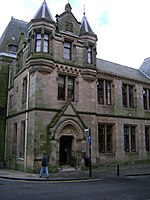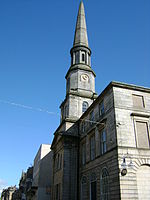Andrew Carnegie Birthplace Museum

The Andrew Carnegie Birthplace Museum is a biographical museum in Dunfermline, Fife, Scotland, dedicated to the life of Scottish-American industrialist and philanthropist Andrew Carnegie, "one of the great Scots of the 19th century.". The museum is operated by the Carnegie Dunfermline Trust and is housed in a category B listed building. The museum site includes the original 18th-century weavers cottage in which Andrew Carnegie was born and a memorial hall added by James Shearer in 1928. Carnegie's wife, Louise Whitfield Carnegie, purchased the cottage in 1895 from William Templeman using a legacy bequeathed to her from her grandfather. Upon the creation of the Carnegie Dunfermline Trust in 1903 the cottage was looked after by the trust and opened to visitors in 1908.
Excerpt from the Wikipedia article Andrew Carnegie Birthplace Museum (License: CC BY-SA 3.0, Authors, Images).Andrew Carnegie Birthplace Museum
Moodie Street, Dunfermline Abbey Parks
Geographical coordinates (GPS) Address Website External links Nearby Places Show on map
Geographical coordinates (GPS)
| Latitude | Longitude |
|---|---|
| N 56.0679 ° | E -3.4612 ° |
Address
Andrew Carnegie Birthplace Museum
Moodie Street
KY12 7PL Dunfermline, Abbey Parks
Scotland, United Kingdom
Open on Google Maps










